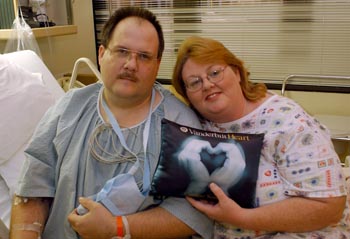
Tim Henderson, with his wife, Sheila, in Vanderbilt University Hospital, is just happy to be alive after surgeons removed a shockingly large blood clot from his chest.
Photo by Dana Johnson
Patient survives huge blood clot
As John Byrne, M.D., began to tease the enormous blood clot from the patient's chest, gasps and exclamations welled up within the operating room.
“Oh my God,” said one of the surgical assistants. “Look at the size of that!”
Byrne, chair of Cardiac Surgery at Vanderbilt, was coaxing a snake-like blood clot more than 12 inches long, the diameter of a nickel and as thick as Jell-O from within the right pulmonary artery of 39-year-old Tim Henderson.
Henderson was flown by LifeFlight from Harton Regional Medical Center in Tullahoma to Vanderbilt University Medical Center in critical condition after being diagnosed with a massive pulmonary embolism.
The condition is a sudden blockage in a lung artery, typically due to a blood clot that forms elsewhere in the body — such as the leg or pelvic region — and then migrates to the pulmonary artery. If the clot is large, or if several clots occur, a pulmonary embolism can cause death.
Henderson's embolism was so massive it blocked all blood flow to his right pulmonary artery and had him to the point of total pulmonary arrest. He was so ill he required resuscitation two times before undergoing emergency surgery.
“We literally snatched Mr. Henderson from the grave,” said Byrne. “In most instances, something as dramatic and massive as this would have killed the patient.”
Byrne says credit goes to Henderson's physician in Tullahoma, Bill George, M.D., who quickly diagnosed the pulmonary embolus; the Tullahoma EMS workers; the staff at Harton Regional Medical Center who performed the first resuscitation; LifeFlight's nurses who transported Henderson here; and to the entire Cardiac Surgery OR team.
“Somehow this gentleman lived. He lived long enough to make it to the ER, long enough to make it to LifeFlight, long enough to make it to our OR, and we got him through surgery,” he said. “It took an entire team approach at multiple levels.”
Byrne says in his career he's never seen anyone survive such a massive pulmonary embolism. “I've published papers on pulmonary embolism surgery, performed a number of these surgeries, and this is the largest embolus I've ever seen.”
Sensing some sort of medical history was about to be made during the procedure one of Byrne's assistants grabbed his cell phone to film the clot's removal, creating a short video of the moment.
“When I saw the video of Tim's surgery I seriously thought, ‘Oh My God,’” said Henderson's wife, Sheila. “They just kept pulling that thing out of Tim's chest. It looked like it was two-feet long and looked like they were pulling a dead snake from inside his chest. I didn't expect anything like this. I was just completely shocked.”
According to the National Heart Lung Blood Institute (NHLBI) more than 600,000 people in the United States have a pulmonary embolism each year, and more than 60,000 die from the disorder.
The NHLBI says in most cases pulmonary embolism is the result of a deep vein thrombosis (DVT), a blood clot that forms deep in the body — most frequently in the legs. The clots break free from the leg veins and travel to the lung, blocking the artery.
Having recently suffered a broken leg and having it immobilized in a cast, Henderson was at increased risk for a pulmonary embolism.
Other risk factors for pulmonary embolism include: prolonged bed rest or inactivity, surgery, massive trauma, burns, oral contraceptive use, childbirth, heart attack, and fractures of the hips or femur.
“They told me I was lucky that I was alive at the Tullahoma hospital. And then I had another miracle happen here at Vanderbilt. I feel very lucky to be alive,” Tim Henderson said. “This happened on Mother's Day. My mother passed away a few years ago and I feel like she was watching over me.”













